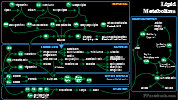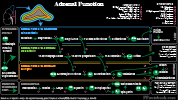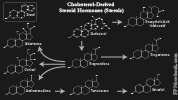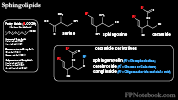II. Definitions
- Lipids
- Organic molecules containing Hydrocarbons
- Poorly soluble in water, but soluble in organic solvents
- Examples include free Fatty Acids, Triglycerides, phospholipids
- Cholesterol
-
Triglyceride
- Lipid composed of three molecules of Fatty Acid esterified to Glycerol
- Triglycerides are a non-polar fat synthesized from Carbohydrates or ingested
- Triglycerides are High Energy Molecules that are stored for later use in animal adipose cells (fat cells)
- Lipoprotein
- Serum Proteins that solubilize hydrophobic lipids (Triglycerides, Cholesterol esters)
- Key to lipid transport through the blood stream
- Contain two components
- Spherical hydrophobic core (Cholesterol, Triglycerides)
- Hydrophilic shell (phospholipids, apolipoproteins)
- Classified by density (Chylomicrons, VLDL, LDL, HDL)
- In general, Lipoproteins transport Cholesterol and Triglycerides to and from the liver and other tissues
- Chylomicrons and VLDL transport both Triglycerides and Cholesterol esters
- Low Density Lipoproteins (LDL) primarily transports Cholesterol
- High Density Lipoproteins (HDL) is a Cholesterol scavenger
- Returns excess Cholesterol and LDL remnants back to the liver
- Serum Proteins that solubilize hydrophobic lipids (Triglycerides, Cholesterol esters)
- Sphingolipid
- Similar to Triglycerides (but with a Serine backbone and other slight structural changes)
- Includes sphingosine and ceramides, of which sphingomyelin is a key component of myelin nerve sheath
III. Physiology: Lipid Metabolism
-

- See Fat Metabolism
- Fats are a high energy (9 kcals/g), long term energy source
- Intestinal Digestion and Absorption of fats
- Duodenal bile salts emulsify fats into small droplets
- Enzymatic breakdown by intestinal and pancreatic agents
- Lipase (intestinal, pancreatic) lyse Triglycerides to monoglycerides and free Fatty Acids
- Esterases lyse Cholesterol to free Cholesterol and free Fatty Acids
- Phospholipases lyse phospholipids to free Fatty Acids and lysophospholipids
- Small micelles form from fat breakdown products and bile acids
- Micelles carry fats to intestinal epithelial cell brush border for absorption
- Bile salts allow for absorption of polar lipids
- Bile salts are reclaimed by enterohepatic circulation
- Bile salts absorbed in ileum are transported back to liver via portal circulation
- Intestinal Epithelial cell Processing of Fats
- Re-forming of lipids
- Triglycerides re-form from free Fatty Acids and monoglycerides
- Cholesterol esters re-form from free Fatty Acids and Cholesterol
- Phospholipids re-form from free Fatty Acids and lysophospholipids
- Chylomicrons
- Form from Apoproteins combined with Triglycerides, Cholesterol to phospholipids
- Chylomicrons move from intestinal epithelial cells into Lymphatic System
- Triglycerides are carried by Chylomicrons to Muscle and fat cells
- Triglycerides are lysed into free Fatty Acids by capillary Lipoprotein Lipase
- Free Fatty Acids are then absorbed by Muscle and fat cells
- Triglycerides reform from free Fatty Acids within Muscle and fat cells (esterification)
- Other Lipoproteins (VLDL, LDL, HDL)
- Form from Cholesterol processing in the liver
- Re-forming of lipids
IV. Physiology: Lipid Functions
- Energy Source
- Fatty Acids are stored for later energy use, bound to Glycerol, as Triglycerides within fat cells
- Fatty Acids are synthesized by adding, in repeated cycles, 2 carbon atoms (acetyl CoA)
- Fatty Acid synthesis occurs in the cytoplasm of most cells to supply numerous uses including cell wall
- Fatty Acids are burned as fuel in the Kreb Cycle (TCA Cycle)
- Fatty Acids are degraded (oxidized) by removing, in repeated cycles, 2 carbon atoms (acetyl CoA)
- Energy from each extracted acetyl coA enters the Kreb Cycle
- Each Kreb Cycle generates NADH and FADH2 (total energy 17 ATP)
- Fats offer high energy stores (9 KCals/g) compared with Carbohydrates and Proteins (4 kcals/g)
- Triglycerides are non-polar and bind less water (more compact than Carbohydrates, Proteins)
- Each triglcyeride contains 3 Fatty Acids, each with 16 to 18 carbons (fueling 24-27 Kreb Cycles)
- Fatty Acids are stored for later energy use, bound to Glycerol, as Triglycerides within fat cells
- Cell Membrane Components
- Cholesterol, Glycolipids and phospholipids are important components of cell membranes
- Cholesterol Derivatives


- Cholesterol
- Cholesterol is a sterol ring structure (four interlinked aromatic rings) critical in physiology
- Cholesterol may either be ingested or synthesized
- Cholesterol synthesis (primarily in the liver)
- Acetyl CoA is converted to isoprene (5 carbon structure)
- Isoprene is combined with other isoprene molecules to form 10, 15 and 30 carbon rings
- Cholesterol (27 carbons) is among many Isoprenoids (isoprene derived molecules)
- Others Isoprenoids include all fat soluble Vitamins (A, D, E and K) and Coenzyme Q
- Steroid Hormones are derived from Cholesterol with unique side chains at the C17 carbon
- Pregnenolone (21 carbons) is derived from Cholesterol
- Sex Hormones, mineralcorticoids and Glucocorticoids are all formed from Pregnenolone
- Sex Hormones
- Testosterone (primarily synthesized in the Testes)
- Estrogen and Progesterone (primarily synthesized in the ovary)
- Dehydroepiandrosterone and Androstenedione (androgens synthesized in the Adrenal Cortex)
- Mineralcorticoids (e.g. Aldosterone, synthesized in the Adrenal Cortex)
- Glucocorticoids (e.g. Cortisol, synthesized in the Adrenal Cortex)
- Pregnenolone (21 carbons) is derived from Cholesterol
- Other Cholesterol derivatives and related Isoprenoids
-
Fatty Acid Derivatives (esp. Arachidonic Acid Derivatives)

- General
- Basic structure is a 5 carbon ring "head" with two 6 to 9 carbon chain "legs"
- Functions vary by specific molecule, but function in general is summarized here
- Thromboxanes
- Increase Platelet aggregation
- Leukotrienes
- Leukocyte chemotaxis
- Prostacyclin
- Inhibits Platelet aggregation
- Vasodilates
- Prostaglandins
- Contracts Smooth Muscle (e.g. Vasoconstriction, bronchoconstriction, uterine contraction)
- Increases inflammatory response as well as pain and fever
- Lipoproteins
- Serum Proteins that solubilize hydrophobic lipids (Triglycerides, Cholesterol esters)
- Key to lipid transport through the blood stream
- Altered Lipoprotein metabolism may result in Hyperlipidemia and increased Cardiovascular Risk
- Contain two components
- Spherical hydrophobic core of Cholesterol ester or Triglycerides
- Hydrophilic shell of phospholipids, Cholesterol and apolipoproteins
- Classified by density
- Chylomicrons
- Lipoproteins carrying Triglycerides and Cholesterol esters from the Small Intestine via Lymphatics to central circulation
- Transport Triglycerides to the fat cells and Muscle, and remaining Cholesterol to the liver
- Very Low Density Lipoproteins (VLDL)
- Similar to Chylomicrons (which have the same density), carrying both Triglycerides and Cholesterol esters
- Very light (0.93 to 1.006 g/ml), large (30-80 nm) Lipoproteins whose cores are primarily Triglycerides
- Surface is a phospholipid and Cholesterol monolayer with embedded apolipoprotein B, E and C
- Transport Triglycerides from the liver to Muscle and fat cells
- First Triglycerides and Apo C are off-loaded
- Next VLDL becomes intermediate density Lipoprotein (IDL)
- Next LDL Cholesterol forms
- Low Density Lipoproteins (LDL)
- Cholesterol laden particles for transport from liver, throughout the body (see Cholesterol function above)
- Small (18-25 nm) and light (1.019 to 1.063 g/ml) Lipoproteins
- Primarily contain a core of Cholesterol esters and a lower concentration of Triglycerides
- LDL transports Cholesterol esters from the liver throughout the body
- Phospholipid monolayer surface contains a single Apolipoprotein A100
- High Density Lipoproteins (HDL)
- HDL is synthesized in the liver as empty, non-lipid bound Proteins (apolipoprotein A1)
- Start as the smallest (4-13 nm) and most dense (>1.063 g/ml) Lipoproteins, without a Cholesterol core
- HDL is a Cholesterol scavenger returns excess Cholesterol and LDL remnants back to the liver, for bile synthesis
- HDL also transports apolipoproteins C2 and E to and from Triglyceride rich Lipoproteins
- Lecithin-Cholesterol acyl transferase (LCAT) enzyme is bound to HDL
- LCAT converts free Cholesterol into more hydrophobic Cholesterol esters
- Cholesterol esters, in turn, are sequestered into Lipoproteins
- HDL is synthesized in the liver as empty, non-lipid bound Proteins (apolipoprotein A1)
- Chylomicrons
- Serum Proteins that solubilize hydrophobic lipids (Triglycerides, Cholesterol esters)
- Sphingolipids

- Similar to Triglycerides with 2 exceptions
- Sphingosine
- Analogous to a monoglyceride, with the first Serine carbon attached to a Fatty Acid (palmitoyl CoA)
- Ceramide
- Analogous to a diglyceride, with the first 2 Serine carbon chains attached to Fatty Acids
- Ceramide serves as a base for many molecules with different attachments at the third carbon
- Sphingomyelin (Choline at the third carbon), a key component of the Myelin Sheath of nerves
- Glycolipids (sugar-lipid combinations)
- Cerebroside (Glucose or Galactose at the third carbon)
- Sulfatides contain Galactose with an attached sulfate
- Ganglioside (Oligosaccharide, with multiple linked sugars at the third carbon)
- Also contain sialic acid (N-acetyl neuraminic acid, NANA), an 11-carbon amino-sugar
- Globoside
- Similar to Gangliosides, but without sialic acid
- Cerebroside (Glucose or Galactose at the third carbon)
V. Precautions
- Total Cholesterol <175 mg/dl in elderly: Increased mortality
VI. Components
VII. Patient Education
- Mnemonic: Lower L-DL, Higher H-DL
VIII. References
- Goldberg (2001) Clinical Biochemistry, Medmasters, Miami, p. 17-23
- Guyton and Hall (2006) Medical Physiology, 7th Ed, Elsevier Saunders, Philadelphia, p. 829-58
